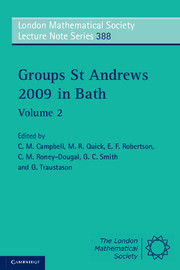Book contents
- Frontmatter
- Contents
- Introduction
- Algorithms for matrix groups
- Residual properties of 1-relator groups
- Words and groups
- The modular isomorphism problem for the groups of order 512
- Recent progress in the symmetric generation of groups
- Discriminating groups: a comprehensive overview
- Extending the Kegel Wielandt theorem through π-decomposable groups
- On the prime graph of a finite group
- Applications of Lie rings with finite cyclic grading
- Pronormal subgroups and transitivity of some subgroup properties
- On Engel and positive laws
- Maximal subgroups of odd index in finite groups with simple classical socle
- Some classic and nearly classic problems on varieties of groups
- Generalizations of the Sylow theorem
- Engel groups
- Lie methods in Engel groups
- On the degree of commutativity of p-groups of maximal class
- Class preserving automorphisms of finite p-groups: a survey
- Symmetric colorings of finite groups
- References
Engel groups
Published online by Cambridge University Press: 05 July 2011
- Frontmatter
- Contents
- Introduction
- Algorithms for matrix groups
- Residual properties of 1-relator groups
- Words and groups
- The modular isomorphism problem for the groups of order 512
- Recent progress in the symmetric generation of groups
- Discriminating groups: a comprehensive overview
- Extending the Kegel Wielandt theorem through π-decomposable groups
- On the prime graph of a finite group
- Applications of Lie rings with finite cyclic grading
- Pronormal subgroups and transitivity of some subgroup properties
- On Engel and positive laws
- Maximal subgroups of odd index in finite groups with simple classical socle
- Some classic and nearly classic problems on varieties of groups
- Generalizations of the Sylow theorem
- Engel groups
- Lie methods in Engel groups
- On the degree of commutativity of p-groups of maximal class
- Class preserving automorphisms of finite p-groups: a survey
- Symmetric colorings of finite groups
- References
Summary
Abstract
We give a survey on Engel groups with particular emphasis on the development during the last two decades.
Introduction
We define the n-Engel word en(x, y) as follows: e0(x, y) = x and en+1(x, y) = [en(x, y), y]. We say that a group G is an Engel group if for each pair of elements a, b ∈ G we have en(a, b) = 1 for some positive integer n = n(a, b). If n can be chosen independently of a, b then G is an n-Engel group.
One can also talk about Engel elements. An element a ∈ G is said to be a left Engel element if for all g ∈ G there exists a positive integer n = n(g) such that en(g, a) = 1. If instead one can for all g ∈ G choose n = n(g) such that en(a, g) = 1 then a is said to be a right Engel element. If in either case we can choose n independently of g then we talk about left n-Engel or right n-Engel element respectively.
So to say that a is left 1-Engel or right 1-Engel element is the same as saying that a is in the center and a group G is 1-Engel if and only if G is abelian. Every group that is locally nilpotent is an Engel group. Furthermore for any group G we have that all the elements of the locally nilpotent radical are left Engel elements and all the elements in the hyper-center are right Engel elements.
- Type
- Chapter
- Information
- Groups St Andrews 2009 in Bath , pp. 520 - 550Publisher: Cambridge University PressPrint publication year: 2011
References
- 13
- Cited by

